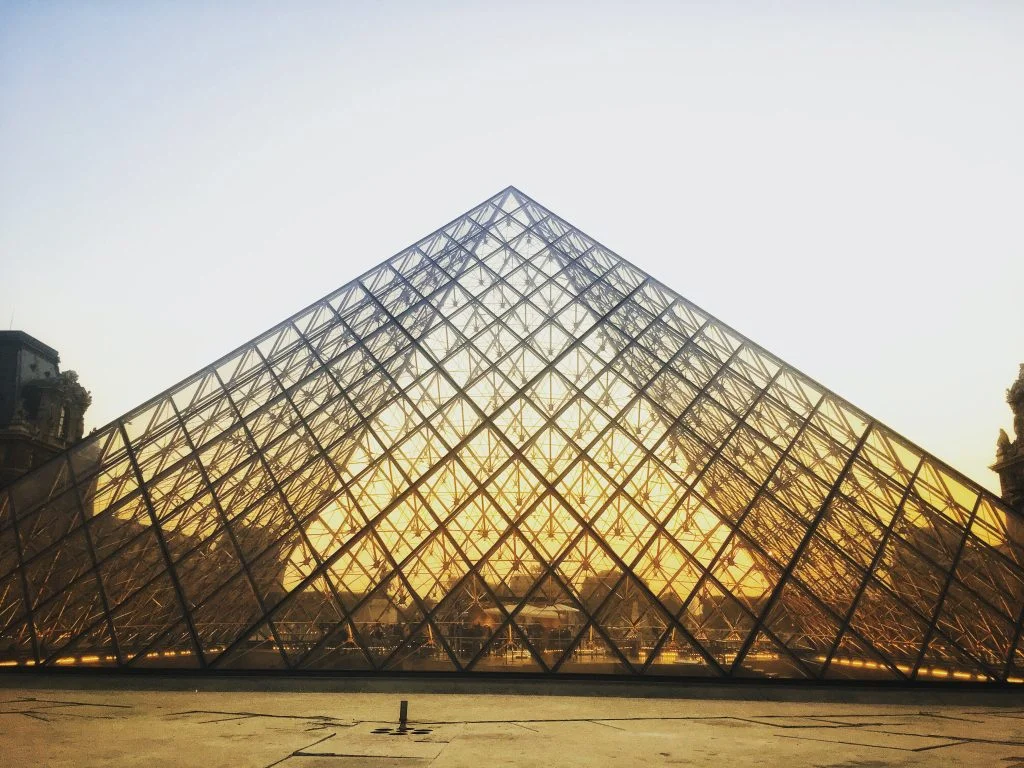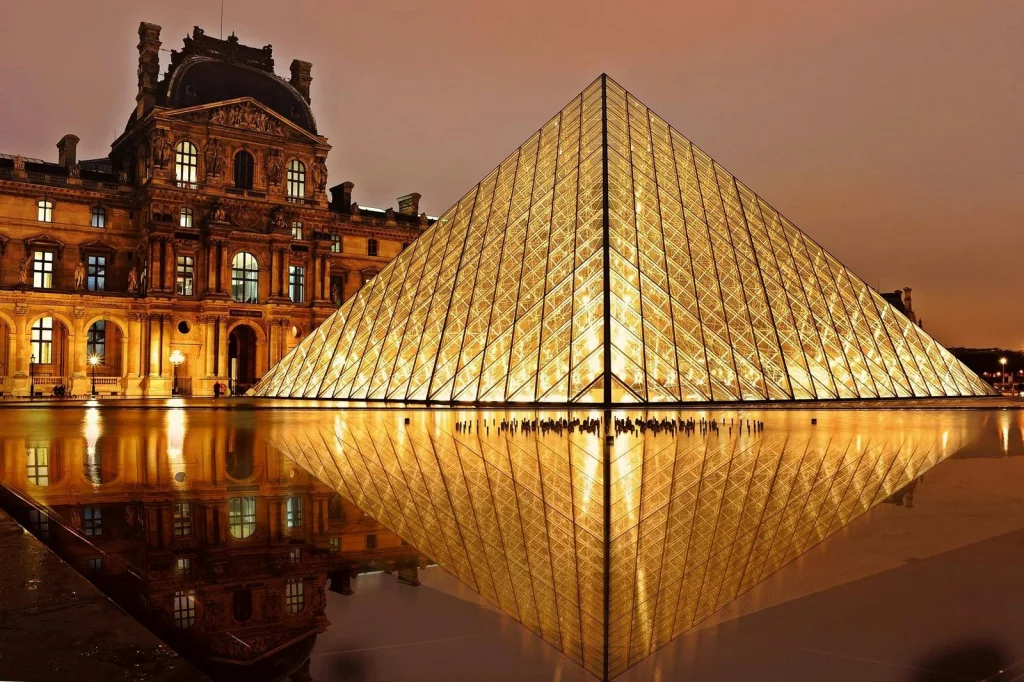Picture this: me, standing in the Louvre, completely amazed, not by the art but by the fact that I’d just seen a kid try to eat a croissant in front of the Mona Lisa. Security did not find it amusing. This was just one of my many unforgettable experiences at the world-famous Louvre Museum. The Louvre, with its paintings that have seen more history than most textbooks and sculptures that make you wonder how anyone could make marble look like flowing fabric, is full of surprises.
Have you ever imagined what it’s like to walk through its endless galleries? Or why are some paintings more guarded than certain embassies? Let’s explore 50 mind-blowing facts about this iconic museum. Buckle up, and maybe bring a snack—just not a croissant!
The Louvre is the book in which we learn to read.
Paul Cezanne
Louvre Museum Facts
These Louvre Museum facts, with their rich history and artistry, will amaze you. Pay close attention to each detail, as there’s a quiz at the end to see how much you’ve learned!
- The Louvre Museum resides in the heart of Paris, France.
- Once serving as a royal residence, the Louvre transitioned into a museum accessible to the public amid the French Revolution.
- Its inauguration took place on August 10, 1793.
- Holding the title of the world’s largest art museum, the Louvre is also a celebrated historical site in Paris.
- The museum boasts a collection exceeding 380,000 items and exhibits more than 35,000 art pieces.
- It occupies the Louvre Palace, which initially started as a fortress in the late 12th century, commissioned by Philip II.
- The renowned Glass Pyramid, a creation of I. M. Pei, marks the main entrance and was completed in 1989.
- Encompassing over 9,000 years of history, the Louvre’s collection is extensive.
- It encompasses 72,735 square meters (782,910 square feet) dedicated to exhibition space.
- Its most acclaimed piece is Leonardo da Vinci’s iconic Mona Lisa.
- Other masterpieces include the renowned Venus de Milo and the majestic Winged Victory of Samothrace.
- The Louvre possesses an exceptional collection of Egyptian antiquities, regarded as one of the world’s best.
- In the 1980s and 1990s, the museum experienced substantial refurbishment, known as the Grand Louvre project.

- The Napoleon III apartments within the museum exemplify the French decorative arts of the 19th century.
- Part of the extensive Louvre Pavilion de l’Horloge, these apartments reflect Renaissance architectural style.
- In 2019, the Louvre stood as the most visited art museum globally, attracting 9.6 million visitors.
- Its galleries include Western artworks from the Middle Ages to 1848 and ancient civilization pieces.
- Renowned for its Greek, Etruscan, and Roman antiquities, the museum is a treasure trove of history.
- Introduced in 2003, its Islamic art collection is expansive and diverse.
- The Denon Wing is the proud home to the celebrated Mona Lisa painting.
- During World War II, the Louvre took precautionary measures to evacuate its artworks to safeguard them from Nazi plunder.
- The museum comprises eight distinct departments: Paintings, Egyptian Antiquities, Near Eastern Antiquities, Greek, Etruscan and Roman Antiquities, Islamic Art, Sculptures, Decorative Arts, and Prints and Drawings.
- Constructed with 673 glass panels, the iconic Glass Pyramid is a sight to behold.
- Offering virtual tours, the museum allows enthusiasts to explore its collections online.
- It has been prominently featured in several films, notably in The Da Vinci Code.
- Boasting one of the richest collections of French paintings worldwide, the museum’s array is unparalleled.
- Noteworthy sculptures include Michelangelo’s Marly Horses and the poignant Dying Slave.
- Originally constructed as a defensive fortress in 1190 by King Philip II, the Louvre has a storied past.

- The Louvre is a key element of the expansive Grand Louvre complex, which also includes the Tuileries Gardens.
- Managed by the French government under the Ministry of Culture, the museum is a national icon.
- Its collection of prints and drawings features illustrious works by artists like Rembrandt and Michelangelo.
- The Near Eastern Antiquities department houses artifacts from ancient civilizations like Mesopotamia, Persia, and Anatolia.
- Exhibiting the Decorative Arts collection, the museum showcases unique objects including the renowned Crown Jewels.
- The museum’s compilation of Renaissance and Baroque paintings includes masterpieces by Raphael and Caravaggio.
- The Richelieu Wing displays an array of French sculptures, Mesopotamian antiquities, and much more.
- Many artworks in the Louvre were amassed during the reigns of French Kings Louis XIV, XV, and XVI.
- The exquisite Apollo Gallery within the Louvre displays regal French crowns and jewels.
- Not only historical, the Louvre is renowned for its modern art exhibitions and contemporary installations.
- It houses an extensive collection of ancient Egyptian mummies and related artifacts.

- The Cour Carrée, the museum’s inner courtyard, is an architectural marvel.
- Famous for its Egyptian Antiquities, the Sully Wing also showcases the revered Seated Scribe sculpture.
- Featuring a library and research center, the museum focuses on art history and conservation studies.
- The Arts of Africa, Asia, Oceania, and the Americas galleries in the Louvre highlight non-Western art forms.
- Offering educational programs and workshops, the museum caters to learners of all ages.
- The Medieval Louvre section retains remnants of the original fortress, adding to its historical significance.
- The Louvre extends its cultural reach internationally through artwork loans and organizing exhibitions across the globe.
- The Islamic Art department showcases over 3,000 pieces, spanning 1,300 years of history.
- Its collection of Gothic and Renaissance decorative arts includes exquisite tapestries and furniture.
- The museum’s Spanish collection features works by famed artists like Goya and El Greco.
- As part of Paris’s historic axis, the Louvre extends along the Champs-Élysées to the majestic Arc de Triomphe.
Louvre Museum Myths

I had so much fun gathering all these facts. I hope you feel the same. But now it’s time to bust some myths. Is one day enough to see the entire museum? Let’s see if this is a myth or not.
- The Louvre is Entirely Dedicated to French Art
While famous for French art, the Louvre is a global museum with diverse works from various cultures and time periods, reflecting its universal museum status. - The Mona Lisa is Housed in a Grand, Spacious Room
A small, often crowded room actually displays the Mona Lisa, surprising many visitors with its modest setting for such a famous painting. - The Louvre was Always a Museum
Originally a 12th-century fortress and then a royal palace, the Louvre became a public museum during the French Revolution, symbolizing the evolving role of art in society. - You Can See the Entire Louvre in One Day
It’s nearly impossible to see the entire Louvre in one day; with over 35,000 works, visitors usually focus on highlights and return for multiple visits. - The Glass Pyramid is Universally Loved
The Louvre’s glass pyramid, designed by I.M. Pei, faced initial controversy for its modern style but has become a celebrated symbol of Paris’s blend of historical and contemporary elements.
No products found.
Louvre Museum Quotes

The Louvre is one of the most famous museums in the world. It’s easy to say there are many iconic quotes around it. Let’s see some together.
The Louvre is the book in which we learn to read.
Paul Cezanne
This quote by the renowned artist Paul Cezanne suggests that the Louvre is a fundamental place for learning and inspiration, particularly in the arts.
You should definitely visit the Louvre, a world-famous art museum where you can view, at close range, the backs of thousands of other tourists trying to see the Mona Lisa.
Dave Barry
Humorist Dave Barry provides a humorous take on the often crowded experience of visiting the Louvre, especially around famous works like the Mona Lisa.
Keep good company – that is, go to the Louvre.
Paul Cézanne
Cezanne here implies that being in the presence of the masterpieces in the Louvre is akin to keeping good company, emphasizing the value and importance of the art housed there.
The Louvre is a morgue; you go there to identify your friends.
Jean Cocteau
This quote from Jean Cocteau offers a more critical or metaphorical perspective, possibly suggesting that the art in the Louvre, while classic, may feel lifeless or static to some.
It took me twenty years to discover painting: twenty years looking at nature, and above all, going to the Louvre.
Pierre-Auguste Renoir
Renoir reflects on his artistic journey, highlighting the Louvre’s significant role in his development and understanding of painting.
Louvre Museum FAQ

Just a few minutes before you take the test (I mean the quiz), we are going to check some frequently asked questions about the Louvre. If you feel confident enough that you know everything, then jump to the next section (don’t do it).
- When was the Louvre Museum built?
The Louvre Museum, originally built as a fortress, dates back to the late 12th to 13th century under the reign of Philip II. Later, they converted it into a royal palace, and it eventually became the magnificent museum we know today. - How long did the Louvre take to build?
The construction of the Louvre as we see it now was not a one-time event. It evolved over centuries, starting from its initial construction in the 12th century. Its transformation from a fortress to a royal palace and finally to a museum involved numerous modifications and extensions over the years. - How to pronounce ‘Louvre’?
‘Louvre’ is pronounced as loo−vruh in English, with a subtle ‘r’ sound at the end. In French, it’s pronounced more like loo−vr, with a softer and more nasal ‘r’. - Can you skip the line at the Louvre?
Yes, it’s possible to skip the line at the Louvre. Purchasing a timed entry ticket in advance can significantly reduce your waiting time. Additionally, there are multiple entrances to the museum, and some, like the Porte des Lions, are less crowded than the main pyramid entrance. - How far is the Louvre from the Eiffel Tower?
The Louvre is about 3 kilometers (roughly 1.9 miles) away from the Eiffel Tower. It’s a lovely walk through some of the most scenic parts of Paris, or a short ride by public transport or taxi.
No products found.
Louvre Museum Trivia

The time to test your knowledge is here. Embark on our Louvre Museum Quiz! A word of caution: if you fail to answer correctly, the ghost of Napoleon might just haunt you from its corridors!
Conclusion
And there we have it, the end of our magical trip through the halls of the Louvre. This place isn’t just a museum; it’s a labyrinth of the world’s imagination, where every turn brings a new surprise (including the occasional line for the restroom). Between dodging selfie sticks and marveling at art that’s older than your entire family tree, the Louvre is an experience unlike any other.
Did you also feel like you were time-traveling with each room? Now, here’s a thought to leave you with: if you could have a Louvre sleepover (imagine the possibilities!), which gallery would you pick as your bedroom for the night? Just promise not to draw mustaches on any portraits, okay? Let me know in the comments.
3 Sources Used For This ArticleGuide Tour of Louvre Museum – Hisour Guide Tour
The Only Guide You Need To Explore The Best of Louvre Museum Paris – Headout


